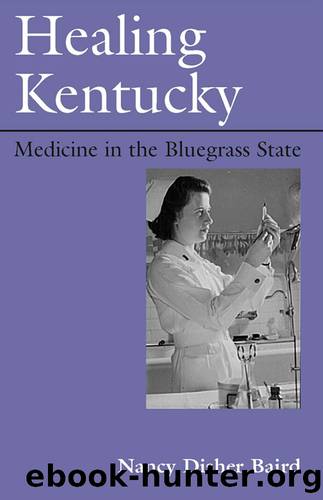Healing Kentucky by Nancy Disher Baird

Author:Nancy Disher Baird [Baird, Nancy Disher]
Language: eng
Format: epub
Publisher: The University Press of Kentucky
Published: 2007-10-15T00:00:00+00:00
A patient with smallpox. The photo was taken before 1980, when smallpox was wiped out around the world due to vaccinations. (Photo courtesy of Library of Congress)
The English army and navy tried the doctorâs method and found that it did indeed prevent smallpox. Throughout the 19th century, other doctors improved his method and learned how to make the vaccine in large amounts. By the 20th century, a safe vaccine to prevent smallpox was available to everyone.
In the early 20th century, Kentucky and other states passed laws saying that all children must be vaccinated against smallpox. Doctors checked to make sure their patients received the vaccine. Schools did not admit children who were not vaccinated. Gradually, fewer people had smallpox. Other nations also required vaccinations. There have been no cases of smallpox anywhere in the world since about 1980.
Smallpox was the first killer disease that scientists learned to prevent. Unfortunately, there are many different kinds of viruses among us. One virus causes measles, another virus causes chicken pox, and yet another causes mumps. Viruses cause many of our worst diseases, including yellow fever, polio, some cancers, and AIDS.
For some of these killers, especially the âchildhood diseases,â such as measles and mumps, scientists have developed vaccines. In the 19th century, half of all children died before they reached the age of ten. Today, because of the vaccines that prevent some of these diseases (and because of improved cleanliness), most little ones live long enough to become adults.
The worst virus to hit in recent times was Spanish flu. The disease caused a high fever, a headache, and a bad cough. Sometimes the air pockets of the lungs filled with bloody fluid. When this happed, the victims could not breathe and died.
Spanish flu killed millions in Europe during the years of World War I (1914â1918). It probably came to the United States with American soldiers coming home from the war. In the United States, Spanish flu killed more than a half-million people in less than a year.
The disease hit Kentucky in September of 1918. The first cases appeared at Camp Taylor, a big Army base near Louisvilleâs Audubon Park. The base hospital quickly filled with sick soldiers. Other buildings became makeshift hospitals. Doctors and nurses from across Kentucky and other states went to Camp Taylor to help care for the sick men. The Red Cross also sent nurses to Camp Taylor. The people of Louisville gave sheets, pillowcases, and blankets for the makeshift hospitals. Area farmers sent wagons loaded with fruits, vegetables, jars of jelly, and freshly baked bread. The students at the Girlsâ High School in Louisville made chicken soup for the soldiers. The squirrel hunters in Simpson County even sent squirrel meat for stew. Everyone helped. Nevertheless, many of the 60,000 soldiers at Camp Taylor died from Spanish flu.
Throughout late September and October, the disease quickly spread across the state. As it spread, and as the death rate rose, the State Board of Health urged Kentuckians to stay at home. Finally, in
Download
This site does not store any files on its server. We only index and link to content provided by other sites. Please contact the content providers to delete copyright contents if any and email us, we'll remove relevant links or contents immediately.
Good by S. Walden(2925)
The Social Psychology of Inequality by Unknown(2319)
0041152001443424520 .pdf by Unknown(2230)
The Checklist Manifesto by Atul Gawande(2209)
The Meaning of the Library by unknow(2078)
23:27 by H. L. Roberts(1896)
Guns, Germs and Steel by Diamond Jared(1894)
Being Mortal: Medicine and What Matters in the End by Atul Gawande(1811)
Borders by unknow(1792)
A Leg to Stand On by Oliver Sacks(1717)
The Hot Zone by Richard Preston(1642)
And the Band Played On by Randy Shilts(1625)
The Valachi Papers by Peter Maas(1520)
The Obesity Epidemic by Robyn Toomath(1429)
The Laws of Medicine by Siddhartha Mukherjee(1420)
The Andromeda Strain by Michael Crichton(1369)
The Plague and I by Betty Macdonald(1270)
Pharmacy Practice and The Law by Richard Abood(1258)
Autism's False Prophets by Paul A. Offit(1246)
